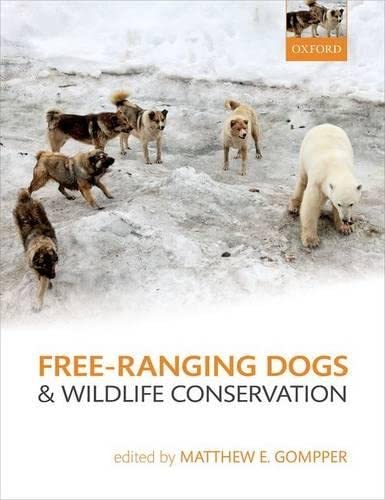

Most ebook files are in PDF format, so you can easily read them using various software such as Foxit Reader or directly on the Google Chrome browser.
Some ebook files are released by publishers in other formats such as .awz, .mobi, .epub, .fb2, etc. You may need to install specific software to read these formats on mobile/PC, such as Calibre.
Please read the tutorial at this link. https://ebooknice.com/page/post?id=faq
We offer FREE conversion to the popular formats you request; however, this may take some time. Therefore, right after payment, please email us, and we will try to provide the service as quickly as possible.
For some exceptional file formats or broken links (if any), please refrain from opening any disputes. Instead, email us first, and we will try to assist within a maximum of 6 hours.
EbookNice Team

Status:
Available5.0
11 reviews
ISBN-10 : 0199663211
ISBN-13 : 9780199663217
Author: Matthew E. Gompper
Dogs are the world's most common and widespread carnivores and are nearly ubiquitous across the globe. The vast majority of these dogs, whether owned or un-owned, pure-bred or stray, spend a large portion of their life as unconfined, free-roaming animals, persisting at the interface of human and wildlife communities. Their numbers are particularly large throughout the developing world, where veterinary care and population control are often minimal and human populations are burgeoning. This volume brings together the world's experts to provide a comprehensive, unifying, and accessible review of the effects of dogs on native wildlife species. With an emphasis on addressing how free-ranging dogs may influence wildlife management and native species of conservation concern, chapters address themes such as the global history and size of dog populations, dogs as predators, competitors, and prey of wildlife, the use of dogs as hunting companions, the role of dogs in maintaining diseases of wildlife, and the potential for dogs to hybridize with wild canid species. In addition, the potential role of dogs as mediators of conservation conflict is assessed, including the role of dogs as livestock guardians, the potential for dogs to aid researchers in locating rare wildlife species of conservation interest, and the importance of recognizing that some populations of dogs such as dingoes have a long history of genetic isolation and are themselves important conservation concerns. A common theme woven throughout this volume is the potential for dogs to mediate how humans interact with wildlife and the recognition that the success of wildlife conservation and management efforts are often underpinned by understanding and addressing the potential roles of free-ranging dogs in diverse natural ecosystems. Free-Ranging Dogs and Wildlife Conservation is aimed at professional wildlife and conservation ecologists, managers, graduate students, and researchers with an interest in human-dog-wildlife interactions. It will also be of relevance and use to dog welfare researchers, veterinary scientists, disease ecologists, and readers with an interest in the interface of domestic animals and wildlife.
1 The dog–human–wildlife interface: assessing the scope of the problem
1.1 Introduction
1.2 The dog is the most common carnivore
1.3 How has the dog–human–wildlife interface developed?
1.4 The demographics and ownership of free-ranging dogs
1.5 Future research needs
Acknowledgments
References
2 Dogs as predators and trophic regulators
2.1 Introduction
2.2 Dog diet: influence of location and ranging behavior
2.3 Predation by dogs and its effects
2.4 Human facilitation of dog predation of wildlife
2.5 Ecosystem-wide effects of dogs
2.6 Future research
References
3 Top-dogs and under-dogs: competition between dogs and sympatric carnivores
3.1 Introduction
3.2 Dogs as interference competitors
3.3 Exploitative competition
3.4 Apparent competition
3.5 Conservation implications
3.6 Further research
References
4 Dogs as agents of disturbance
4.1 Introduction
4.2 Dogs as stimuli
4.3 The response of wildlife
4.4 The impacts of dog disturbance on wildlife
4.5 Managing dog disturbance
4.6 Research needs
Acknowledgments
References
5 Dog eat dog, cat eat dog: social-ecological dimensions of dog predation by wild carnivores
5.1 Introduction
5.2 Focal examples of wild carnivore predation on dogs
5.3 Synthesis
5.4 Implications for wild carnivore conservation
5.5 Conclusions
Acknowledgments
References
6 Dogs, disease, and wildlife
6.1 Introduction
6.2 The pathogen community
6.3 Reservoirs of infection
6.4 How species boundaries are crossed
6.5 Managing interspecies transmission
References
7 Impact of hybridization with domestic dogs on the conservation of wild canids
7.1 Introduction
7.2 Effects of hybridization
7.3 Hybridization is often directional
7.4 Hybridization, but limited introgression
7.5 Cases of introgression
7.6 When does hybridization occur?
7.7 Conservation implications
7.8 Conclusion
7.9 Future research
Acknowledgments
References
8 Dog conservation and the population genetic structure of dogs
8.1 Introduction
8.2 An overview of dog diversity
8.3 Africa
8.4 Oceania and Island South-east Asia
8.5 Mainland Eurasia
8.6 The Americas
8.7 Conserving dog diversity
8.8 Conclusions
Acknowledgments
References
9 Dogs as mediators of conservation conflicts
9.1 Introduction
9.2 History of use of dogs in conservation and management
9.3 Reducing predation in agricultural systems
9.4 Livestock protection dog breed selection
9.5 Non-traditional uses in other conservation conflicts
9.6 Potential limitations, conflicts, and problems
9.7 Conclusions and future directions
References
10 The current and future roles of free-ranging detection dogs in conservation efforts
10.1 A brief history of detection dogs
10.2 Use of free-ranging detection dogs in conservation: selected case studies
10.3 Maximizing safety and success when using free-ranging conservation detection dogs
10.4 Future role of free-ranging dogs in conservation
Acknowledgments
References
11 Hunting dogs and the extraction of wildlife as a resource
11.1 Introduction
11.2 Interspecific biases in harvests with dogs
11.3 Intraspecific biases in harvests with dogs
11.4 Spatial responses of wildlife to hunting with dogs
11.5 Conclusion
Acknowledgments
References
12 The human dimensions of dog–wildlife interactions
12.1 Introduction
12.2 Conceptual basis
12.3 Human dimensions research on dog–wildlife interactions
12.4 Discussion and recommendations
12.5 Future research
what is wildlife and its conservation
ways to conserve wildlife
is animal conservation important
what is conservation animals
free-ranging wildlife veterinarians
Tags: Free Ranging, Wildlife Conservation, Matthew Gompper